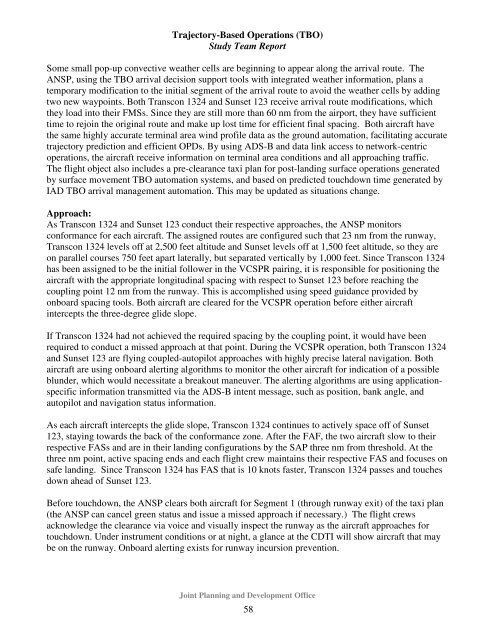Trajectory-Based Operations (TBO) - Joint Planning and ...
Trajectory-Based Operations (TBO) - Joint Planning and ...
Trajectory-Based Operations (TBO) - Joint Planning and ...
You also want an ePaper? Increase the reach of your titles
YUMPU automatically turns print PDFs into web optimized ePapers that Google loves.
<strong>Trajectory</strong>-<strong>Based</strong> <strong>Operations</strong> (<strong>TBO</strong>)<br />
Study Team Report<br />
Some small pop-up convective weather cells are beginning to appear along the arrival route. The<br />
ANSP, using the <strong>TBO</strong> arrival decision support tools with integrated weather information, plans a<br />
temporary modification to the initial segment of the arrival route to avoid the weather cells by adding<br />
two new waypoints. Both Transcon 1324 <strong>and</strong> Sunset 123 receive arrival route modifications, which<br />
they load into their FMSs. Since they are still more than 60 nm from the airport, they have sufficient<br />
time to rejoin the original route <strong>and</strong> make up lost time for efficient final spacing. Both aircraft have<br />
the same highly accurate terminal area wind profile data as the ground automation, facilitating accurate<br />
trajectory prediction <strong>and</strong> efficient OPDs. By using ADS-B <strong>and</strong> data link access to network-centric<br />
operations, the aircraft receive information on terminal area conditions <strong>and</strong> all approaching traffic.<br />
The flight object also includes a pre-clearance taxi plan for post-l<strong>and</strong>ing surface operations generated<br />
by surface movement <strong>TBO</strong> automation systems, <strong>and</strong> based on predicted touchdown time generated by<br />
IAD <strong>TBO</strong> arrival management automation. This may be updated as situations change.<br />
Approach:<br />
As Transcon 1324 <strong>and</strong> Sunset 123 conduct their respective approaches, the ANSP monitors<br />
conformance for each aircraft. The assigned routes are configured such that 23 nm from the runway,<br />
Transcon 1324 levels off at 2,500 feet altitude <strong>and</strong> Sunset levels off at 1,500 feet altitude, so they are<br />
on parallel courses 750 feet apart laterally, but separated vertically by 1,000 feet. Since Transcon 1324<br />
has been assigned to be the initial follower in the VCSPR pairing, it is responsible for positioning the<br />
aircraft with the appropriate longitudinal spacing with respect to Sunset 123 before reaching the<br />
coupling point 12 nm from the runway. This is accomplished using speed guidance provided by<br />
onboard spacing tools. Both aircraft are cleared for the VCSPR operation before either aircraft<br />
intercepts the three-degree glide slope.<br />
If Transcon 1324 had not achieved the required spacing by the coupling point, it would have been<br />
required to conduct a missed approach at that point. During the VCSPR operation, both Transcon 1324<br />
<strong>and</strong> Sunset 123 are flying coupled-autopilot approaches with highly precise lateral navigation. Both<br />
aircraft are using onboard alerting algorithms to monitor the other aircraft for indication of a possible<br />
blunder, which would necessitate a breakout maneuver. The alerting algorithms are using applicationspecific<br />
information transmitted via the ADS-B intent message, such as position, bank angle, <strong>and</strong><br />
autopilot <strong>and</strong> navigation status information.<br />
As each aircraft intercepts the glide slope, Transcon 1324 continues to actively space off of Sunset<br />
123, staying towards the back of the conformance zone. After the FAF, the two aircraft slow to their<br />
respective FASs <strong>and</strong> are in their l<strong>and</strong>ing configurations by the SAP three nm from threshold. At the<br />
three nm point, active spacing ends <strong>and</strong> each flight crew maintains their respective FAS <strong>and</strong> focuses on<br />
safe l<strong>and</strong>ing. Since Transcon 1324 has FAS that is 10 knots faster, Transcon 1324 passes <strong>and</strong> touches<br />
down ahead of Sunset 123.<br />
Before touchdown, the ANSP clears both aircraft for Segment 1 (through runway exit) of the taxi plan<br />
(the ANSP can cancel green status <strong>and</strong> issue a missed approach if necessary.) The flight crews<br />
acknowledge the clearance via voice <strong>and</strong> visually inspect the runway as the aircraft approaches for<br />
touchdown. Under instrument conditions or at night, a glance at the CDTI will show aircraft that may<br />
be on the runway. Onboard alerting exists for runway incursion prevention.<br />
<strong>Joint</strong> <strong>Planning</strong> <strong>and</strong> Development Office<br />
58
















